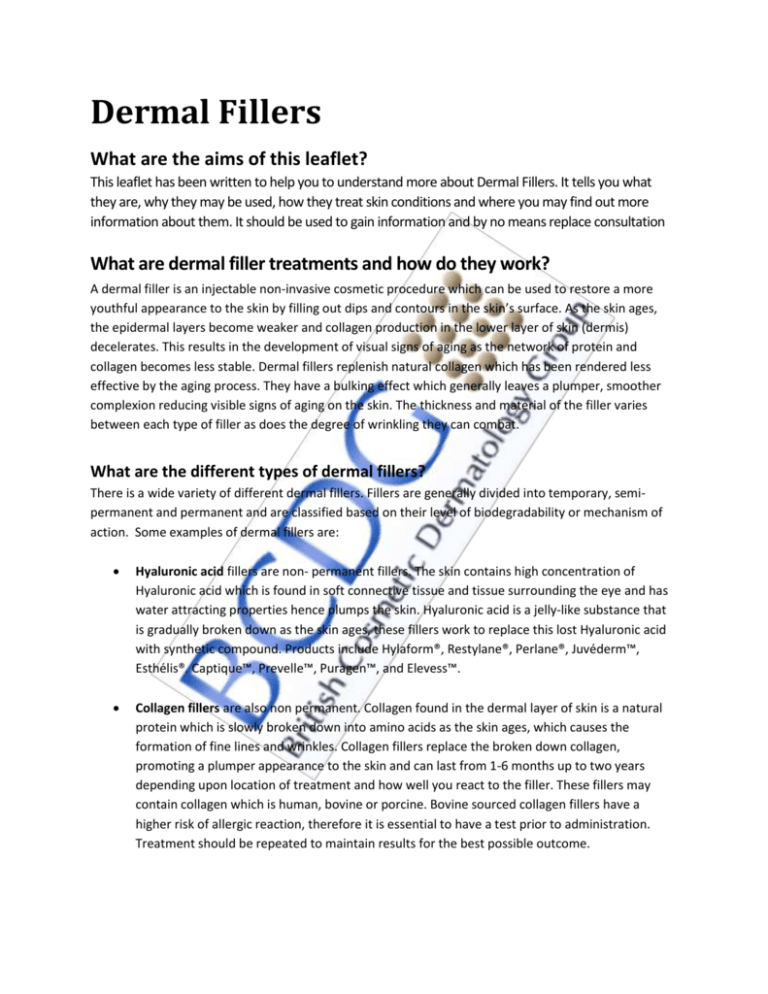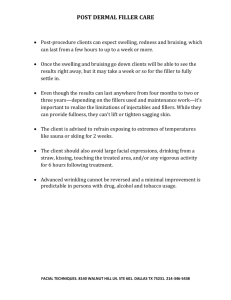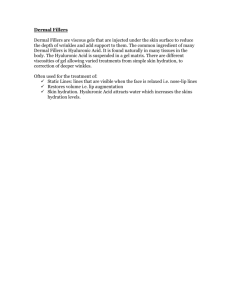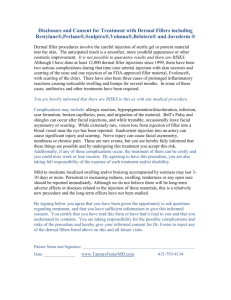info sheet
advertisement

Dermal Fillers What are the aims of this leaflet? This leaflet has been written to help you to understand more about Dermal Fillers. It tells you what they are, why they may be used, how they treat skin conditions and where you may find out more information about them. It should be used to gain information and by no means replace consultation What are dermal filler treatments and how do they work? A dermal filler is an injectable non-invasive cosmetic procedure which can be used to restore a more youthful appearance to the skin by filling out dips and contours in the skin’s surface. As the skin ages, the epidermal layers become weaker and collagen production in the lower layer of skin (dermis) decelerates. This results in the development of visual signs of aging as the network of protein and collagen becomes less stable. Dermal fillers replenish natural collagen which has been rendered less effective by the aging process. They have a bulking effect which generally leaves a plumper, smoother complexion reducing visible signs of aging on the skin. The thickness and material of the filler varies between each type of filler as does the degree of wrinkling they can combat. What are the different types of dermal fillers? There is a wide variety of different dermal fillers. Fillers are generally divided into temporary, semipermanent and permanent and are classified based on their level of biodegradability or mechanism of action. Some examples of dermal fillers are: Hyaluronic acid fillers are non- permanent fillers. The skin contains high concentration of Hyaluronic acid which is found in soft connective tissue and tissue surrounding the eye and has water attracting properties hence plumps the skin. Hyaluronic acid is a jelly-like substance that is gradually broken down as the skin ages, these fillers work to replace this lost Hyaluronic acid with synthetic compound. Products include Hylaform®, Restylane®, Perlane®, Juvéderm™, Esthélis®. Captique™, Prevelle™, Puragen™, and Elevess™. Collagen fillers are also non permanent. Collagen found in the dermal layer of skin is a natural protein which is slowly broken down into amino acids as the skin ages, which causes the formation of fine lines and wrinkles. Collagen fillers replace the broken down collagen, promoting a plumper appearance to the skin and can last from 1-6 months up to two years depending upon location of treatment and how well you react to the filler. These fillers may contain collagen which is human, bovine or porcine. Bovine sourced collagen fillers have a higher risk of allergic reaction, therefore it is essential to have a test prior to administration. Treatment should be repeated to maintain results for the best possible outcome. Calcium Hydroxyapatite fillers-are long lasting fillers which can be in the form of a solid implant or a paste. The body accepts the solid implant and the soft tissue and bone begin to form ingrowths into the implant. The substance is non-biodegradable and is not resorbed by the body, it is therefore classed as a permanent filler. Poly L Lactic Acid- it is injected deep into the dermis or subcutaneous space this stimulates an irritation under the skin to make body produce more collagen. It also encourages a tightening and lifting due to collagen production and causes deep filling. An example of a Poly L lactic acid is Sculptra™. If you have never used fillers before, often temporary filler appeal to patients initially in order to establish that they are comfortable before they to commit to a permanent filler. What can be treated using dermal fillers? Dermal fillers are one of the most effective anti-aging treatments, used to plump up fine lines and wrinkles and recapture a youthful appearance. They are commonly used as a procedure for defining and restoring thin lips along with enhancing shallow contours of the skin. They can be used by both men and women at filling lines between the nose and corner of the lips, as well as smile lines on the cheeks. They can be used effectively to improve the appearance of recessed scars, including those as a result of acne. Are there any risks associated with dermal fillers? As with any procedure there are risks involved with the use of dermal fillers so it is important to be aware of the limitations of the procedure. Different fillers can cause different side effects and symptoms may present at different times. You may experience: Bruising, swelling and redness can occur around the site of the injection and may last 2-3 days before they vanish completely. Bleeding may occur at the injection site directly after the injection due to the use of a needle. Itching Skin discolouration occurs very rarely around the injection site. There is a small risk of allergic reaction to the filler, if you are concerned about or notice any signs of infection for example prolonged redness, swelling or any signs of fever seek attention from your doctor as soon as possible. If you notice any hard lumps forming around the injected site or if it is painful to touch, contact your doctor as soon as possible. Cold sore recurrence- Patients with a history of cold sores may experience a recurrence after treatment, although this can be minimised by the use of antiviral medicines. If any of these symptoms persist or last longer than a week, or if any other side effects develop, contact your doctor who will be able to offer the best course of treatment Will I feel any pain? Depending on the area injected and the type of filler used, the procedure can be relatively painless to mildly uncomfortable. Treatment into the nose or lip area may be slightly more painful. Sometimes a mild anaesthetic cream is applied to the area of treatment 20 minutes or so prior to injection What happens after the procedure? Aftercare is simple and does not generally interfere with a patient’s routine. A few aftercare instructions are listed below; however your doctor will instruct you as to the best program for the filler you have received. Avoid exposure to heat and sunlight as this might increase the risk of bleeding. You should avoid alcohol consumption for 12 hours post treatment Avoid chemical peels, laser skin resurfacing, laser skin tightening, and other laser enhancements directly after treatment, they may cause inflammation. Post-treatment pain should be minimal. A common complaint among those who have undergone treatment is swelling, though this should subside in the first few days after the injection. If you are experiencing discomfort you may take Paracetamol. Do not take an Aspirin based product as this may increase the risk of bleeding or bruising. Healing time varies from person to person, however, so some may experience redness and swelling slightly longer than others. If you continue to experience painful swelling or any sign of blistering you should contact your practitioner You may be advised to avoid flexing your facial muscles in the area of treatment. Stretching your muscles might disturb the filler. For the first 24 hours after treatment, try to avoid sudden movements in the enhanced area. For example, if you have undertaken treatment for lip augmentation your doctor might advised you against excessive laughing, as this might stretch the surrounding muscles and bother the filler. You may use a cold pack as needed to reduce swelling and redness at the injection site. Is a Dermal Filler right for me? You should alert your doctor if you: Suffer from hypersensitivity to products Have a history of allergy or anaphylaxis Have formed keloids in the past Suffer from autoimmune disease Are pregnant or breastfeeeding Have ever suffered from rheumatoid arthritis; psoriatic arthritis; systemic or discoid lupus erythematosus; or polymyositis. This may cause a reaction to a specific ingredient in some fillers. Take specific medication such as beta blockers. Make sure your physician is aware of any medication you are taking. Your doctor may refuse treatment if it is not considered in your best interests to proceed. Results are determined by a number of factors, including your skin type, facial structure, your lifestyle and your perception. Patients should ensure that they have discussed their expectations with their doctor at consultation to ensure that no patient is unhappy with the results of their filler. Where can I find out more information? Find a doctor http://www.fda.gov/MedicalDevices/ProductsandMedicalProcedures/CosmeticDevices/Wrinkl eFillers/ucm227749.htm http://webarchive.nationalarchives.gov.uk/+/www.dh.gov.uk/en/Publichealth/CosmeticSurger y/DH_4121415




